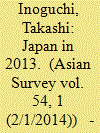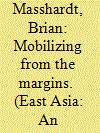| Srl | Item |
| 1 |
ID:
130192


|
|
|
|
|
| Publication |
2014.
|
| Summary/Abstract |
This article describes the ups and downs and complexities of Japanese PrimeMinister Abe Shinzo's ''Abenomics'' and ''Abegeopolitics,'' political approaches designed to revitalize Japan's economy and restore its national pride and strength, respectively.
|
|
|
|
|
|
|
|
|
|
|
|
|
|
|
|
| 2 |
ID:
080460


|
|
|
|
|
| Publication |
2007.
|
| Summary/Abstract |
Prime Minister Koizumi's six consecutive annual visits to Yasukuni shrine played a key role in initiating a new phase of domestic citizen political mobilization not seen since the early 1970s. This paper is based on field research during the Koizumi years (2001-2006) centering on domestic groups that conduct activities in "protection" of or "opposition" to Yasukuni shrine. As a study of street-based politics, this paper seeks to uncover the processes, strategies, and outcomes of citizen responses to elite political action at Yasukuni Shrine as well as explore meaning of their actions within the context of Japan's democratic polity
|
|
|
|
|
|
|
|
|
|
|
|
|
|
|
|
| 3 |
ID:
086461


|
|
|
|
|
| Publication |
2008.
|
| Summary/Abstract |
Although Margaret Keck and Kathryn Sikkink formulated the concept of a transnational advocacy network (TAN) as a tight-knit community of transnational nongovernmental individuals with shared beliefs and identities, they did not go on to trace the dynamics of the development of such a network. This paper claims that "shared values" is an insufficient explanation for network-building. It further expands on the analytical framework for the development of a TAN by discussing the following three main themes: (1) the political opportunity that catalyzes the emergence of the activists; (2) the network "glue" that facilitates cohesion and closeness in the TAN; and (3) the network organization that defines the participation and problems related to role distribution with respect to the activists in the TAN. This study examines the case of the anti-Yasukuni TAN comprising activists from Taiwan, South Korea, and Japan, and finds that the TAN was transformed in terms of its function and strategy as activists of different national origins joined it. From the evidence gleaned from structured interviews, it was found that activists from Taiwan instilled the TAN with a revolutionary character that facilitated the mobilization of wider social support. Ambitious activists from South Korea then added a greater international dimension to the TAN. Although the groups from Taiwan and South Korea tended to accelerate the development of the TAN and diversify it, the Japanese group reminded the developing TAN of its original target. Thus, a TAN is a far more complex entity with a mixture of multinational and cultural attributes rather than a simple and steady network formed by transnational actors with shared beliefs, as Keck and Sikkink have posited.
|
|
|
|
|
|
|
|
|
|
|
|
|
|
|
|